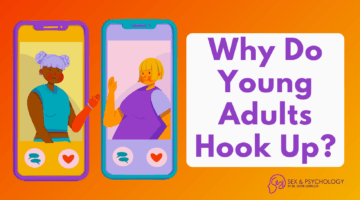How Many Gay Men Say They Are Bisexual When They’re Coming Out?
April 16, 2018 by Justin Lehmiller
In an episode of the classic television series Sex and the City, Carrie Bradshaw discovers that a guy she’s seeing has dated both men and women. Uncomfortable with the thought of taking things further, she confides to her friends: “You know, I did the ‘date a bisexual guy’ thing in college, but in the end they all ended up with men…I’m not even sure bisexuality exists. I think it’s just a layover on the way to gaytown.”
Carrie expressed a belief that a lot of people in the real world hold, too—that all bisexual men are secretly gay and just aren’t quite ready to come out. However, the stereotype that all bisexual men are gays in disguise is, like Sex and the City, pure fiction (see here and here for scientific evidence that bisexuality is a distinct sexual orientation). That said, it turns out that there is some truth to the idea that bisexuality sometimes serves as a transitional sexual identity.
Transitional bisexuality has largely been ignored by sex researchers to date; however, a recent study published in the Archives of Sexual Behavior sheds some light on it. In this study, researchers recruited men who currently identified as gay via both Facebook and Grindr. A total of 58 participants (most of whom were White and age 26 on average) completed an online survey about their sexual attitudes and histories. Thirty-six of these participants went on to complete a lab study in which their genital arousal patterns were recorded while they watched different kinds of porn.
It turned out that nearly half (48.3%) of participants had identified as bisexual at a previous point in time. Of those who had, most (60.7%) said they had sex with a woman before, too; by contrast, among those who had never identified as bisexual, just 6.7% reported having had sex with a woman.
When asked about their reasons for identifying as bisexual, the two that were most commonly endorsed were that it was easier to think of oneself as bi than as completely gay (60.7%) and that others might have an easier time accepting them as bi instead of completely gay (67.9%).
Less commonly endorsed reasons included: wanting a future with a wife and children (21.4%), being sexually attracted to both men and women (21.4%), and having previously masturbated while thinking of both men and women (17.9%). Note that participants could select more than one reason.
Consistent with these findings, most (82.1%) of men who had previously identified as bisexual reported that they did not currently believe themselves to have been bisexual in the past.
The other really interesting finding from this paper came from the genital arousal portion of the study. Men who previously identified as bisexual did not demonstrate higher genital arousal or higher self-reported sexual arousal in response to woman-on-woman porn compared to men who had never identified as bisexual. In other words, those who previously identified as bisexual did not show any current evidence of increased sexual attraction to women.
Given the small number size of this study, we should be cautious in generalizing the results; however, these findings are still informative because they offer some useful scientific insight into the phenomenon of transitional bisexuality.
These results suggest that male transitional bisexuality is common and that it seems to have more to do with coming to terms with a gay identity than with actually being bisexual. The fact that this is so common is probably what has given rise to the popular stereotype that male bisexuality is nothing but “a layover on the way to gaytown.”
Importantly, these findings also suggest that a history of bisexual identification among gay men should not necessarily be viewed as evidence of sexual fluidity, given that most of the men who adopt this temporary identity don’t actually have bisexual feelings. Scientists studying sexual fluidity therefore need to keep in mind that transitional bisexuality is indeed a thing.
Want to learn more about Sex and Psychology? Click here for more from the blog or here to listen to the podcast. Follow Sex and Psychology on Facebook, Twitter (@JustinLehmiller), or Reddit to receive updates. You can also follow Dr. Lehmiller on YouTube and Instagram.
For more on this research, see: Semon, T.L., Hsu, K.J., Rosenthal, A.M., & Bailey, J.M. (2017). Bisexual phenomena among gay-identified men. Archives of Sexual Behavior, 46(1), 237-245
Image Source: 123RF/mavoimage
You Might Also Like:

Dr. Justin Lehmiller
Founder & Owner of Sex and PsychologyDr. Justin Lehmiller is a social psychologist and Research Fellow at The Kinsey Institute. He runs the Sex and Psychology blog and podcast and is author of the popular book Tell Me What You Want. Dr. Lehmiller is an award-winning educator, and a prolific researcher who has published more than 50 academic works.
Read full bio >


